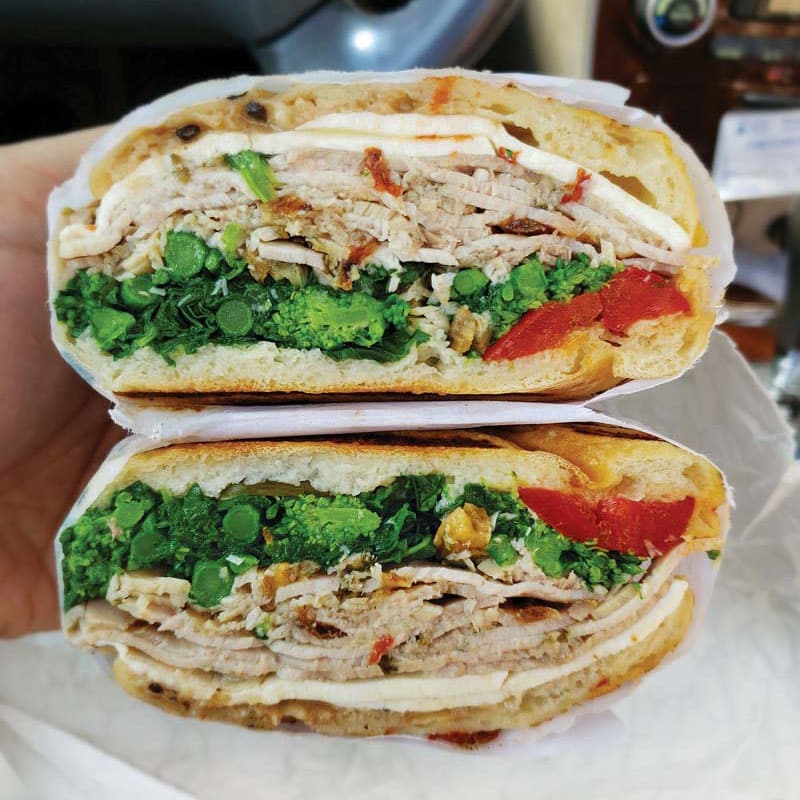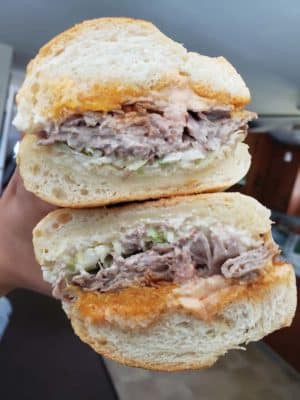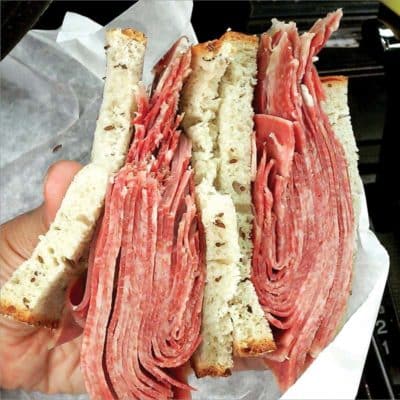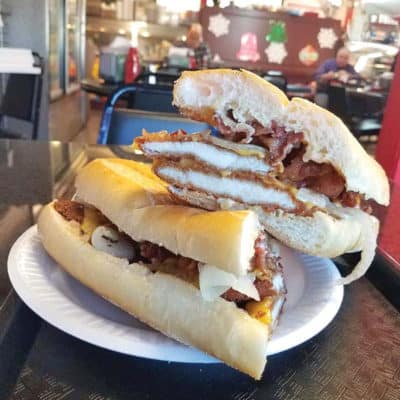In praise of our greatest kitchen creation

tradition continues at Jewish delis across the island. (Photos by Steve Mosco)
Where do I even begin with sandwiches? This is a food item so ubiquitous in culinary pop culture that focusing on any one style in particular would be an insult to the entire planet’s sandwich collective. There are breakfast sandwiches so good that they give you a reason to get out of bed in the morning. Lunch breaks exist solely so that we might spend an hour alone with a really good sandwich. Dinners have bent to the will of sandwiches and even dessert has been infiltrated by the ice cream sandwich.
We don’t deserve sandwiches. Blissfully simple in their conception and construction, sandwiches take food that could be fine on its own, and place it inside of an endless variety of bread. This gives us the freedom to pick up said food with our bare hands and bring it directly to our mouths. Sandwiches are a heavenly concoction of meats, cheeses, produce, sauces and spreads, all brought together with equally genuine excitement by both professional chefs and those with absolutely no business being in a kitchen.
Sandwiches are the great equalizer. They can be dirt cheap or expensive extravaganzas. Not only that, but sandwiches are everywhere—if you haven’t had one yet today, it’s probably because you either forgot it at home, dropped it by accident or have plans to have one later. August is National Sandwich Month and in the spirit of celebration, pile high the history and the adoration.
Sandwich Zero
By all accounts, the 4th Earl of Sandwich John Montagu was a degenerate gambler. His secret, yet rather substantial gambling problem often kept the notorious fuddy-duddy of 1700s London at the card tables for hours, even days on end. As the story goes, during one particularly heightened gaming binge in 1762, Montagu grew hungry. But rather than leave the game so that he could eat in the kitchen or dining room like a proper gentleman, Montagu requested that the house cook bring him something he could eat with one hand and without getting up from his presumably lucky seat.
And thus, the sandwich was born.
Composed of simply meat and bread, the cook’s contribution to his or her employer’s gambling problem impressed Montagu so much that he would eat it constantly. He carried sandwiches around everywhere—one in his hand and sometimes even a few hidden in the many pockets of his dapper coat. To impress his high-society friends, he would stand in the middle of a party and demand everyone’s attention before revealing his sandwich with a showman’s flair, presumably accompanied by a hearty, “huzzah!” These meat-on-bread creations became so inextricably linked to Montagu that the rest of London eventually attached the Earl’s moniker to them.
Of course, Montagu wasn’t the first person to put meat on bread and eat. Down in the Mediterranean, where Turkish and Greek mezze platters were served, dips, cheeses and meats were all “sandwiched” between layers of bread and eaten by locals long before Montagu played his first card game. History is likely full of these kinds of misrepresentations—but I’ll let this one slide, mostly because I just love the word “sandwich” too much to care.

The Sum Of Its Parts
Like most impeccable inventions before and after it, the sandwich’s design has remained constant since it was first conceived in 1762. But while you can’t improve perfection, it is possible to enhance it. Cured meats, artisanal cheeses, freshly baked bread of various origins, piquant aioli, crisp lettuce and juicy tomatoes; all of these and more equal better sandwiches for you and me. And all these ingredients result in the greatest visual byproduct of any food: the cross section. A chance to view with your own eyes the grand design of the sandwich, the ideal cross section lays bare the layers of meat, cheese and then some like a geographical record of flavor.
Two of the most important ingredients of any sandwich are the meat and cheese. Really, meat is the cornerstone of any sandwich—Montagu knew it and now, you know it. Start with slices of whole-roasted turkey or sweet and savory ham. Perhaps some rare or medium rare roast beef is your meat of choice or maybe an expertly fried chicken cutlet is what makes your sandwich sing. No matter the meat, don’t be afraid to add even more on top of that meat with the addition of fatty bacon. And on the subject of cheese, some say cheese overpowers the rest of the sandwich and, thus, is unnecessary. To that I say, take care to use the correct cheese. Sometimes a simple American will suffice and other times a sharp cheddar is in order. If both of those are too intensely flavored, go with a subtle Swiss or mozzarella, which is high on texture but low on overall flavor.
And don’t forget about the bread, for it is more than merely a means to keeping everything together. Your sandwich bread should be a combination of doughy, crispy, chewy and crusty, with flavors and textures all serving to heighten the decadent experience.
Where The Sandwiches Are
Luckily, Long Island features too many master purveyors of sandwiches to list here. You probably have your own favorite spot, but expand your horizons and try a new sandwich every now and then. After all, John Montagu likely died penniless so that ordering a sandwich would always be a safe bet for the rest of us.






















